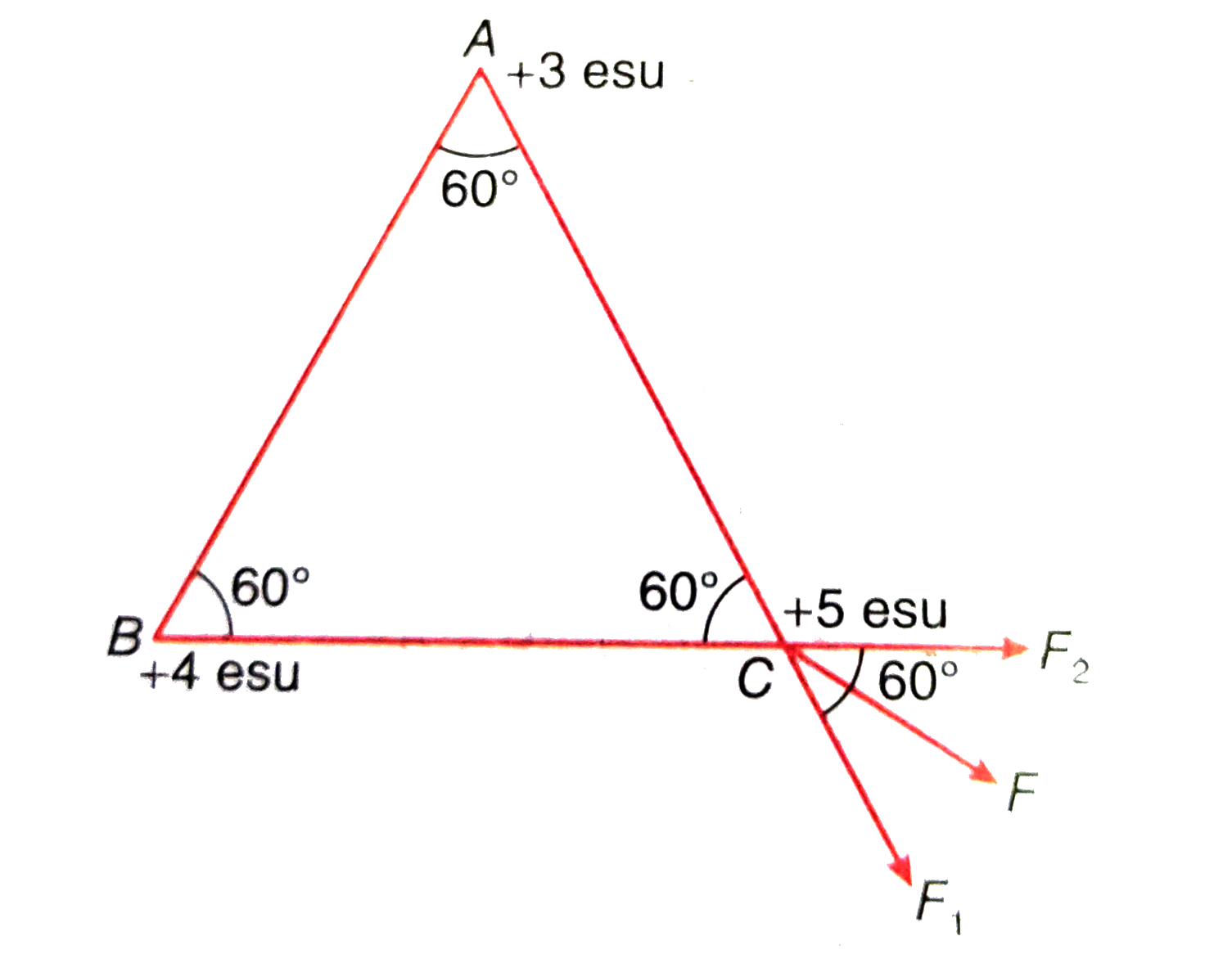Three positive charge 3 esu, 4 esu and 5 esu are placed at the vertices of an equilateral triangle of side 10 cm. What is the force acting the largest charge?Solution in Bengali
Three charges are placed at the corners of the equilateral triangle ABC. The largest charge i.e. 5 esu is situated at the point C.

Force acting on the charge at C due to the charge of A
F1=3×5(10)2=0.15 dyn, along −−→AC
Force acting on the charge at C due to the charge at B,
F2=4×5(10)2=0.2 dyn, along −−−→BC0
∴ Resultant force acting on the charge at C,
F=√F21+F22+2F1F2cos60∘
=√(0.15)2+(0.2)2+2×0.15×0.2×0.5
=√90.0925)=0.304dyn
Topper's Solved these Questions
- BOOK - CHHAYA PUBLICATIONCHAPTER - ELECTRIC FIELDEXERCISE - SECTION RELATION QUESTIONS50videos
ELECTRIC FIELD
- BOOK - CHHAYA PUBLICATIONCHAPTER - ELECTRIC FIELDEXERCISE - HIGHER ORDER THINKING SKILL QUESTIONS33videos
ELECTRIC FIELD
- BOOK - CHHAYA PUBLICATIONCHAPTER - ELECTRIC ENERGY AND POWEREXERCISE - CBSE SCANNER7videos
ELECTRIC ENERGY AND POWER
- BOOK - CHHAYA PUBLICATIONCHAPTER - ELECTRIC POTENTIAL EXERCISE - CBSE Scanner13videos
ELECTRIC POTENTIAL
Similar Questions
State Coulomb's law regarding the force of interaction between two point charge. Define the unit of charge from this law.
02:22View SolutionTwo charges, +qand−q are separated by a distance d. At which points will the resultant electric field intensity be directed parallel to the line joining the charges ?
02:21View SolutionA light bulb is rated 100 W for 220 V ac supply of 50 Hz. Calculate
the resistance of the bulb ,04:04View SolutionA test charge q is moved without acceleration along the path from A to B from B to C in electric field E as shown in fig.

(i) Calculate the potential difference between A and C.07:52View SolutionThe ratio of the emu of charge to esu of charge is :
05:05View Solutionआवेश की ईo एसoयूo (esu), ईo एमoयूo तथा कुलोम इकाई मई सम्बन्ध लिखिए।
01:30View SolutionAt each of the four vertices of a square of side 10 cm, four positive charges each of 20 esu are placed. Find the potential at the point of intersection of the two diagonals.
04:30View SolutionFour point charges of +100 esu,-50 esu +20 esu and +30 esu are placed respectively at the four vertices A,B,C,D of a square of side 10 cm. Find the electric intensity and potential at the point of intersection of the diagonals.
01:42View SolutionA negative charge of 30 esu is at a distance of 30 cm from a positive charge of 20 esu. What is the potential at a point 10 cm from the first charge on the line joining the two charges? Where will the potential be zero?
04:14View SolutionTwo charges of +40 esu and −35 esu separated by a distance of 10 cm, exert 4 dyn force on each other. Determine the dielectric constant of the medium.
04:35View SolutionA+250 esu of charge P is On the line joining other two charges Q (+50 esu of charge ) and R(−300 esu of charge) in between them. Distance of P from Q is 5 cm and from R it is 10 cm. What the resultant force acting on P?
(##CHY_DMB_PHY_XII_P1_U01_C02_SLV_006_Q01.png" width="80%">05:39View SolutionDefine 1 esu of charge
View SolutionNumber of esu of charge in 1C is
04:09View SolutionTwo point charges +4 esu and +9 esu are placed 10 cm apart. At what point on the line joining them will a unit positive charge experience (i) an equal but opposite and (ii) an equal and unidirectional force?
03:23View SolutionTwo insulated metal spheres of the same size are charged with −15 esu and +25 esu. The distance between their centres is 10 cm. What is the force acting between the two charges? If the two spheres are made to touch each other and then placed in their previous positions, what will be the force acting between them?
01:59View Solution

